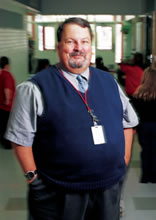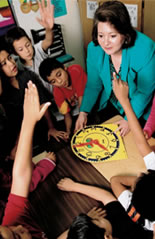| |

Becoming a teacher in Texas

An
Ordinary Life
Education
Crisis
Songs
of the Shaman
Sam
Moon Madness
|
|
|
Greg
Slaughter (’79 M.Ed.) thought about leaving the teaching profession
in 1983 after 10 years on the job.
“I didn’t feel as effective as I could be,” he
says.
Now an assistant principal at A.S. Johnston Elementary in the Irving
Independent School District, Slaughter says the turnaround came
when he took UNT’s field-based graduate courses at Duncanville
High School.
“I credit these courses with keeping me in the profession,”
he says.
Teachers
needed
According
to 10-year projections from the U.S. Department of Education, 1.7
to 2.7 million new public school teachers will be needed across
the nation by 2008. Some will replace teachers who leave the profession
or retire, while others will be needed to keep pace with increasing
enrollments.
In Texas, officials are reporting a projected deficit of tens of
thousands of educators.
“The teacher shortage could grow to 60,000 vacancies by the
year 2010 if our current policies and strategies about teacher recruitment
and retention remain unchanged,” says Ed Fuller, co-director
of research for the Texas State Board of Educator Certification,
the agency responsible for certifying public teachers.
UNT’s College of Education is working to address the shortage,
both by training new teachers and by encouraging veteran teachers
to remain in the field.
Staying
in school

|
 |
 |
Greg Slaughter (’79 M.Ed.), assistant principal at A.S.
Johnston Elementary School in Irving, credits UNT’s field-based
graduate courses with keeping him in the profession.
|
 |
 |
Current
teachers can take a variety of courses on the Denton campus as well
as at other North Texas locations, says Diane Allen, associate dean
of the College of Education and associate professor of teacher education
and administration.
Professional
certification and graduate programs in education are offered at
the UNT Dallas Campus (also known as the UNT System Center), and
field-based graduate courses are currently taught in the Northwest,
McKinney, Plano and Allen school districts.
“With
these courses, UNT professors help teachers renew their commitment
to teaching,” Allen says.
Slaughter, who was named Irving’s Teacher of the Year in 1985,
agrees and says the field-based counselor education courses he took
vastly improved his teaching skills.
“Those courses taught me how to deal with students,”
he says. “You learn about listening techniques and group dynamics.
That helped me become more kid-centered than I was before.”
New
to the field
In
addition to sustaining teachers already in the profession, UNT is
among the leading producers of new teachers in Texas.
According to the SBEC, 586 students graduated from UNT in the 2001-02
academic year with teacher certification — the second-highest
number at a Texas public university. The UNT teacher preparation
program is one of only two Texas university programs that have produced
more than 500 teachers per year every year since 1992.
And UNT is the only university in the Dallas-Fort Worth area whose
education program has been accredited by the National Council for
Accreditation of Teacher Education since 1995, says Jean Keller,
dean of the College of Education and professor of kinesiology, health
promotion and recreation.
The council evaluates such areas as student knowledge and skills,
field experiences, diversity, and faculty performance and development.
Meeting these standards helps ensure that UNT graduates will have
a positive impact on student learning, Keller says.
Uncovering
potential
 |
 |
 |
| |
 |
 Martha
Alarcon (’02 M.Ed.), a fourth-grade bilingual teacher
at Davis Elementary School in Plano, helps her students overcome
their fear of difficult subjects. Martha
Alarcon (’02 M.Ed.), a fourth-grade bilingual teacher
at Davis Elementary School in Plano, helps her students overcome
their fear of difficult subjects.
|
Martha Alarcon
(’02 M.Ed.), a fourth-grade bilingual teacher at Davis Elementary
School in Plano, is one such graduate. She was named Plano’s
Teacher of the Year and the League of United Latin American Citizens
Educator of the Year in 2000.
She says the instruction she received at UNT put her “on the
right path.”
“I’m committed to teaching,” she says. “It’s
my dream to show students they can dream, too.”
Using teaching techniques she learned from UNT professors, Alarcon
shows her students their potential by helping them overcome their
fear of difficult subjects.
For example, she uses an analogy to help her math students convert
hours to minutes, making elapsed time problems easy to solve.
“I advise students to set up a bank account of time. The way
100 pennies equals one dollar, 60 minutes equals one hour.”
Alarcon’s methods work. For the past two years, her Hispanic
students’ passing rate on the Spanish math TAAS test has been
100 percent, up from 17 percent the previous year.
“When they pass this test,” says Alarcon, “they’re
on the way to realizing their dreams.”
Giving
back

|
 |
 |
The students of Jennifer Herring (’82 M.Ed.), chair of
the computer science department at Ursuline Academy in Dallas,
are designing web sites that benefit the community.
|
 |
 |
Jennifer
Herring (’82 M.Ed.) also has high hopes for herself and her
students.
Herring, the chair of the computer science department at Ursuline
Academy in Dallas, grew up in a family of nine children, where “opportunities
were limited.”
“I started my professional career as a computer programmer
because of the high salary,” says Herring. “But, I felt
unfulfilled and decided to change careers.”
Herring has been a teacher for more than 10 years. She says she
chose teaching and UNT because both fit her values.
“Education has been a savior,” she says. “My professors
were approachable, warm and intelligent.”
She says the UNT program offered great practical classroom experience.
“Before I graduated, I had a real sense of what it’s
actually like to work in a school system,” she says. “Now,
as a computer teacher, I’m making a viable contribution.”
Herring’s students are using skills they learned in her class
to design web sites for nonprofit organizations that benefit the
community.
Influencing the lives of students and affecting the community in
a positive way has also been Slaughter’s focus.
He became aware of that influence when he received a letter from
a former student who had become a principal himself.
“You know you’ve made a difference in someone’s
life when they follow in your footsteps,” Slaughter says.
“I’ve touched thousands of lives as an educator. Those
lives will touch thousands more.
|
|




